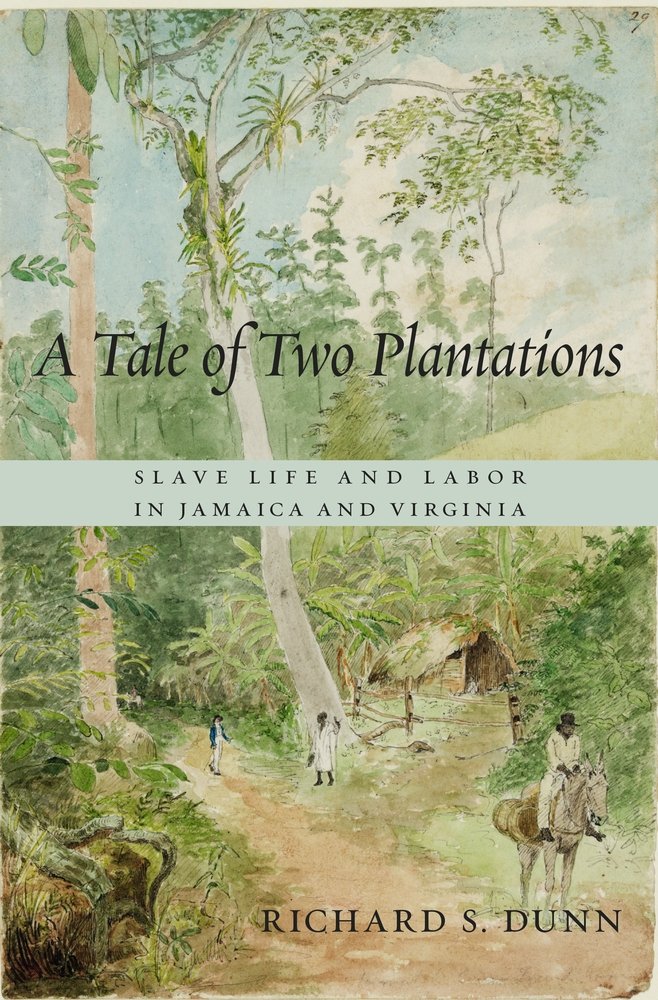A Tale of Two Plantations
By Richard S. Dunn

A Tale of Two Plantations: Slave Life and Labor in Jamaica and Virginia
By Richard S. Dunn
552 pp., Harvard University Press
$31.95
Forty years ago, after publication of his pathbreaking book “Sugar and Slaves,” Richard Dunn began an intensive investigation of two thousand slaves living on two plantations, one in North America and one in the Caribbean.
Digging deeply into the archives, he has reconstructed the individual lives and collective experiences of three generations of slaves on the Mesopotamia sugar estate in Jamaica and the Mount Airy plantation in tidewater Virginia, to understand the starkly different forms slavery could take. Dunn’s stunning achievement is a rich and compelling history of bondage in two very different Atlantic world settings.
From the mid-18th century to emancipation in 1834, life in Mesopotamia was shaped and stunted by deadly work regimens, rampant disease, and dependence on the slave trade for new laborers. At Mount Airy, where the population continually expanded until emancipation in 1865, the “surplus” slaves were sold or moved to distant work sites, and families were routinely broken up. Over two hundred of these Virginia slaves were sent eight hundred miles to the Cotton South.
In the genealogies that Dunn has painstakingly assembled, we can trace a Mesopotamia fieldhand through every stage of her bondage, and contrast her harsh treatment with the fortunes of her rebellious mulatto son and clever quadroon granddaughter. We track a Mount Airy craftworker through a stormy life of interracial sex, escape, and family breakup. The details of individuals’ lives enable us to grasp the full experience of both slave communities as they labored and loved, and ultimately became free.
Scroll down for our Q&A with Richard S. Dunn, a finalist for the 2015 George Washington Prize.
 Grateful American™ Foundation: What inspired you to write this book?
Grateful American™ Foundation: What inspired you to write this book?
Richard S. Dunn: I became interested in the history of racial slavery in America when writing Sugar and Slaves (1972), a book about early English colonization in the Caribbean islands. It became clear to me that African slavery in the Caribbean was very different from African slavery on the North American mainland, and I looked for a way to compare and contrast the two forms of human bondage. I decided to focus on two well-documented plantations, and soon found excellent records for Mesopotamia plantation in Jamaica and Mount Airy plantation in Virginia. But it has taken me forty years to shape these records into a book.
Grateful American™ Foundation: What are the three big lessons you hope readers will take away from it?
Richard S. Dunn: Finding out about slave life — history from the bottom up — is difficult because slaves leave very few records. So first, I demonstrate that the historian can reconstruct the individual and collective experiences of enslaved people by using the slaveholders’ records. I open to view the lives of a thousand men, women and children at Mesopotamia and a thousand men, women and children at Mount Airy, showing these people in action during three generations, and tracing many individual life stories and family relationships.
Second, I demonstrate that the most basic difference between Caribbean and North American slavery was demographic. Mesopotamia had a continually shrinking slave population, with many more deaths than births, which was standard throughout the Caribbean, so the slaveholders had to bring in hundreds of replacement slaves to keep the plantation operating. Mount Airy by contrast had a continually expanding slave population, with many more births than deaths, which was standard throughout the USA, so the slaveholders always had many surplus slaves to move to new worksites or to sell to new owners.
Third, I argue that slavery caused terrible suffering to the black people in the Caribbean and in the Old South, but in strikingly dissimilar ways. At Mesopotamia the slaves were thrown together in an environment in which ill health and death dictated the course of events. At Mount Airy the slaves lived in an environment in which normal social life was impossible, because families were routinely ripped apart.
Grateful American™ Foundation: When was the moment in your life when you developed a passion for American history? And what do you think can be done to inspire more kids to get excited about learning about the past?
Richard S. Dunn: I have always loved history, but over the years I have totally changed my approach to the subject. My mother was English, and from early childhood I was great attracted to the romance and drama of English history — more than to American history. I wrote my senior thesis in college on Archbishop Laud, enemy of the English Puritans. In graduate school I shifted from 17th-century England to 17th-century New England, and wrote about the Winthrop family, so I was still focusing on leading public figures and viewing history from the top down. But as I became increasingly interested in social history, and in the lives of ordinary people in the past, I saw the value of history from the bottom up — and “A Tale of Two Plantations” is the result.
I would like to see more attention paid to well-designed bottom-up history in school and college. Obviously young people should learn about great leaders like Washington and Lincoln, and major past political achievements. But our history is also tragic in many respects, and children can learn from the brutalities of the past. I was surprised when well-educated non-historian adult friends of mine who read my book were shocked to discover the horrible plight of the Mesopotamia and Mount Airy slaves. I assumed that every educated person knew that slavery was totally degrading, but now I see the need for more education on this subject. And I believe that it would be good for young Americans of all racial backgrounds to read frank and honest accounts of what it was like to be a slave.
The website accompanying my book, www.twoplantations.com, which presents mini-biographies of 431 of the 2,000 slaves in my book, is designed as a teaching tool for college students. But I believe that high school students might well be interested in it as well.
Grateful American™ Foundation: If you win the George Washington Prize, what will you do with the prize money — and what will be your goal to accomplish during your year of being the reigning Award winner?
Richard S. Dunn: When I learned that I was a finalist for the George Washington Prize, I immediately decided that if I won I would give some of the award money to the History Design Studio at Harvard University, which designed and built my www.twoplantations.com website for me. Although I didn’t win the George Washington Prize, I was fortunate enough to win an Anisfield-Wolf Book Award from the Cleveland Foundation for the best nonfiction book on race and slavery in 2015. And I am giving half of that award — $5,000 — to the History Design Studio in grateful thanks for their beautifully designed website.
And while I didn’t win the George Washington Prize, I am grateful to the judges who nominated me a finalist, because this honor has generated publicity that will cause more readers to take notice of my book and its messages.
The results are in!
In addition to Richard Dunn’s “A Tale of Two Plantations,” be sure to check out the other books that were also up for the 2015 prize.




